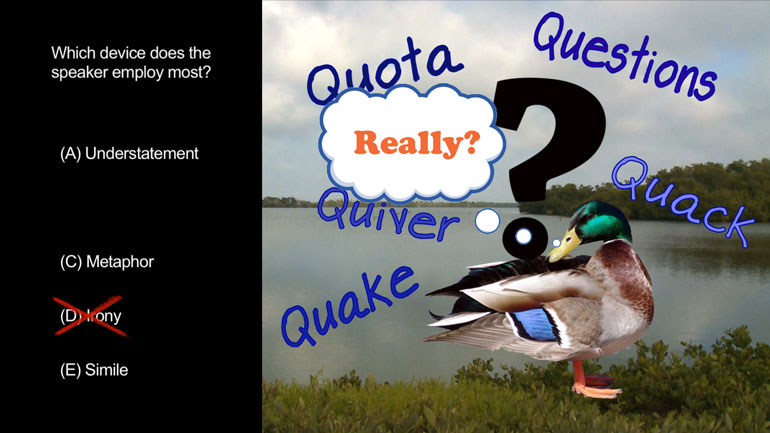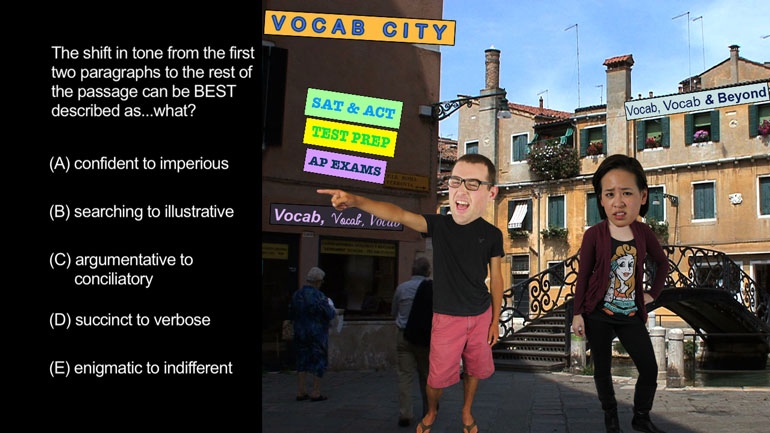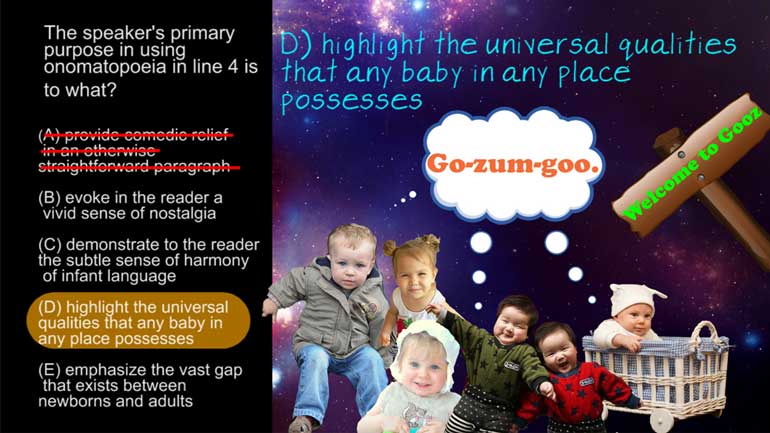ShmoopTube
Where Monty Python meets your 10th grade teacher.
Search Thousands of Shmoop Videos
AP English Language and Composition 6.1 Passage Drill 211 Views
Share It!
Description:
AP English Language and Composition 6.1 Passage Drill. The phrase "Mass it" in line 2 refers to what?
Transcript
- 00:00
[ musical flourish ]
- 00:03
And here's your Shmoop du jour, brought to you by the private sphere,
- 00:07
basically the area you shouldn't invade unless
- 00:09
you know a person pretty darn well.
- 00:11
My precious.
Full Transcript
- 00:12
Okay, so we've just finished reading a bunch of ginormous passages
- 00:16
from eight different sources and, boy, are our eyes tired. [ groan ]
- 00:20
This free response question wants us to use at least
- 00:23
three of the eight sources in our essay answer
- 00:25
and it also wants that essay to be coherent and, well,
- 00:29
well-written. Jeez, so demanding.
- 00:31
All right, so we're given this prompt.
- 00:33
Read the following sources (including the introduction) carefully. Duh.
- 00:37
Then write an essay in which you analyze how women were represented in both
- 00:41
the public sphere and private sphere.
- 00:44
So we need to read through the sources and use the content to develop
- 00:47
our position on how women are represented in, hmm, a couple of sphere thingies.
- 00:53
Sphere things. Yeah, these.
- 00:55
Well, really, we can just ignore the "sphere" part.
- 00:58
It wants us to analyze women's roles in the home as well as
- 01:00
the working world. Now, how do we attack this thing?
- 01:03
Well, slow and stealthy from the left flank, right?
- 01:06
First of all, we need to recognize that our prompt is telling us to
- 01:09
analyze, not argue. Big diff.
- 01:12
So no getting defensive and throwing a hissy fit.
- 01:15
This is all about exploring and evaluating the eight different
- 01:19
approaches to a single subject, not about trying to convince our reader of something.
- 01:23
Got that? We need to stay professional and unbiased,
- 01:26
like a television reporter who will lose his job if he's
- 01:29
caught editorializing.
- 01:30
Can't hurt to make sure our hair looks nice, either.
- 01:34
We also know that we need to discuss both women in the
- 01:37
public sphere, the labor force,
- 01:40
and in the private sphere, like Home on the Range.
- 01:44
Some of the sources refer to one or the other,
- 01:46
so we know we'll have to pull from a couple of each to cover our bases.
- 01:50
Sources A, F, and H are all pro-public.
- 01:54
B, C, and D think that women should be home in the kitchen making babies.
- 01:58
E and G deal with women appearing in public, even if they aren't
- 02:02
strictly about them joining the workforce.
- 02:04
So, which to choose? So many options.
- 02:07
It's like trying to pick out a pair of pumps when DSW is having a sale.
- 02:10
Tough.
- 02:11
If you read the passages carefully,
- 02:13
you should notice that some of them naturally work together.
- 02:16
A and C, for example, even though they demonstrate stances on each side of the issue,
- 02:21
are both from the New Jersey Constitution,
- 02:24
so they're clearly linked.
- 02:26
Less obvious,
- 02:27
sources F and H are both about women speaking and defending their rights.
- 02:32
E and G are both about how men view women appearing in public.
- 02:36
And B and D would probably be appalled that today's women no longer wear hoop skirts and corsets.
- 02:41
In other words, they have some pretty old-fashioned ideas about a woman's role in society.
- 02:45
The tones and perspective may differ from one another,
- 02:48
but, as long as we can draw comparisons and make connections,
- 02:51
we can compose an essay that is thoughtful,
- 02:53
well-researched, and compelling.
- 02:55
Don't forget to start with a thesis.
- 02:58
We can't know where we're going if we haven't first determined where we're starting from.
- 03:02
Remember not to insert your own opinion.
- 03:05
It might be difficult in cases such as these where there are so many
- 03:08
boneheaded, antiquated ideas being bandied about,
- 03:10
but, hey, it was a different time.
- 03:12
And, besides, it's our job to analyze the arguments of others,
- 03:15
what they did make a good case for,
- 03:17
how they structured their arguments, et cetera.
- 03:20
Include at least one pro-public and one pro-private.
- 03:24
And get at the heart of what these writers believed
- 03:26
and why they might have believed those things at that time.
- 03:29
Before you start a-writin', or maybe after you're done,
- 03:32
check out this sample essay to get an idea of
- 03:34
what those AP gurus are all looking for.
- 03:37
Yeah, this one.
- 03:39
My precious.
Up Next
AP English Literature and Composition 1.1 Passage Drill 7. The primary purpose of this passage is what?
Related Videos
Take a look at this shmoopy question and see if you can figure out which device the speaker employs the most.
Feel like shifting gears and answering a question about shifting tones? We've got you covered. Take a look at this question and see if you can foll...
AP English Language and Composition: Passage Drill Drill 1, Problem 2. What is the speaker's primary purpose in using onomatopoeia in line four?
Wishing upon a star may help you pass your AP English Language and Composition test, but answering this question would be a safer bet.




